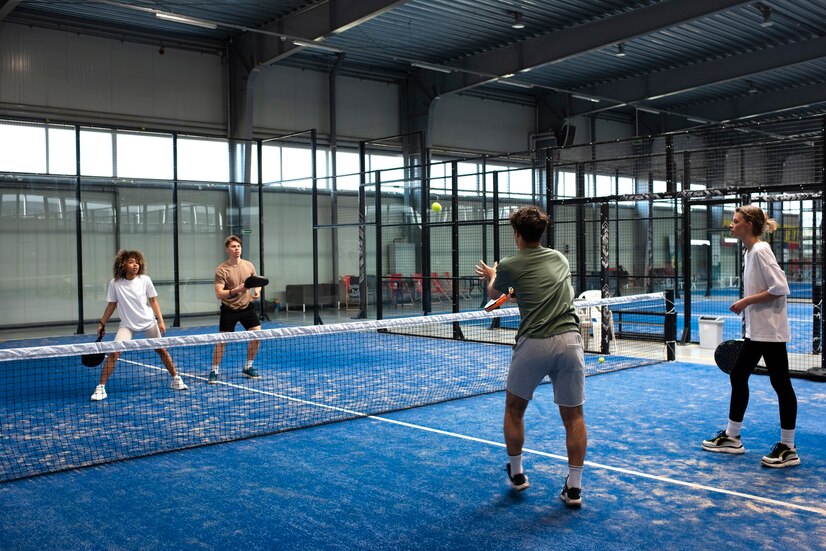Padel, a fast-growing racket sport, is subject to precise standards in terms of court construction and layout. These standards are essential to ensure that the game is played fairly and enjoyably. Among them, the height of the padel court is crucial. It has a direct influence on the flow of exchanges and the continuity of the game. In this article, we’ll take a look at the standards to be met when it comes to the height of a padel court.
Why is the height of a padel court important?
The height of a padel court is not simply a question of aesthetics or a vague technical requirement. It responds to specific needs related to the game itself:
- Facilitating bounces: An environment with insufficient height can disrupt bounces and alter the quality of exchanges.
- Ensuring player safety: An adequate height prevents players from bumping into obstacles above them, which can happen when smashes or high lobs are made.
- Preparing for competitions: Height standards are crucial if the court is to be approved for official competitions. This is a guarantee of quality demanded by the federations.
Official height standards for a padel court
The International Padel Federation (FIP) has set precise standards for the height of a padel court. Here’s what they are:
- Minimum height: The minimum obstacle-free height above the playing surface must be 6 metres. This includes both indoor and outdoor installations.
- Recommendation for indoor installations: To ensure a better playing experience, it is recommended that the height be increased to 8 metres. This prevents high balls from being disturbed by the ceiling.
Additional Padel Court Height Characteristics
As well as simply taking height into account, there are other aspects linked to the vertical dimension of a padel court to consider:
- Walls: The walls surrounding the court should generally be at least 3 metres high. This ensures that the ball bounces properly off the walls.
- Fences: Fences can be erected above the walls, and their height can vary between 1 and 4 metres depending on local specifications and the needs of the court.
- Nets: A central net divides the pitch into two equal halves. The standard height of the net is 88 cm at the centre of the pitch and 92 cm at the ends.
Consequences of non-compliant heights
Non-compliance with height standards can have several repercussions:
- Player discomfort: Players may be hindered by obstacles that interfere with their movements, particularly when serving or lobbing.
- Approval refused: Courts that do not meet FIP standards cannot be approved for official competitions. This severely limits their use.
- Increased risk of accidents: Insufficient height can lead to injuries, especially during intense phases of play when the players’ attention is mainly focused on the ball.
Solutions for insufficient height
If the height of an existing padel court is inadequate, there are several possible solutions:
- Modernising the facility: It may be necessary to raise the roofs or completely redesign the architecture of the facility to comply with standards.
- Removing or reducing obstacles: In some cases, removing or relocating obstructive structures may be enough to comply with height standards.
- Building a new site: For very old or poorly configured facilities, building a new site may be the most appropriate solution.
How Height Affects Padel Court Types
The different types of padel court can influence the way in which height standards are applied:Indoor courts: Indoor padel courts often have to work within the constraints of existing buildings. However, it is crucial to provide sufficient headroom to suit the sport.Outdoor courts: These courts generally offer more flexibility in terms of height, except when installed in urban areas restricted by bylaws or neighbouring structures.
Impact on the Game and the Player Experience
Respecting height standards has a direct impact on the quality of the game:
- Fluidity of exchanges: The right height allows the game to flow more smoothly, without interruptions caused by balls hitting the ceiling or other obstacles.
- Quality of lobs and smashes: These shots often require a high clearance height. Respecting them ensures a better quality of play and strategy for the players.
- Mental comfort: Players are more relaxed and can concentrate fully on the game without fear of limitations due to high obstacles.
Height standards and choice of equipment
Compliance with height standards also has an impact on the choice of materials and equipment:
- Padel balls: High-quality balls are designed for optimum bounce, also depending on the vertical space available.
- Rackets: Although the shape and material of rackets are not directly influenced by the height of the court, an appropriate height maximises the effectiveness of the racket, allowing for more varied shots.
- Nets: Proper respect for net heights ensures that the line of play is not disturbed, contributing consistently to fairness and competition.
Consulting and Expertise to Meet Standards
For owners or managers of padel courts, it can be useful to consult experts to ensure compliance with height standards:
- Specialised architects: They can propose appropriate solutions for existing and new infrastructures.
- Sports consultants: They can provide their expertise to ensure that facilities comply with sporting standards.
- Equipment suppliers: Working with reputable suppliers, such as Bandeja Shop, ensures that you choose equipment that meets quality and compliance standards.
In conclusion, the height of the padel court is essential for the quality of the game, the safety of the players and the homologation of the facilities. Following the standards set by the International Padel Federation and working with experts are necessary steps for any manager wishing to offer an optimal and compliant playing experience. If you have any questions about padel equipment or would like installation advice, don’t hesitate to visit our shop or contact our experts at Bandeja Shop.

